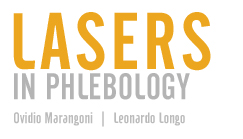

LASERS IN PHLEBOLOGY
powered by incip.it
INTRODUCTION
“Only the right theories should last”
Doctors, human beings, even if are tireless workers, can unfortunately make mistakes, and provoke serious injuries to their patients.
A skilful and clever surgeon was undoubtedly the real leading actor, but nowadays surgery benefits by mini invasive technologies. However the surgical instruments in many operating rooms are often out-of-date, like those in use 50 years ago. Among the not so young surgeons, only few of them can assert that they have never got a shock or have involuntarily burned their patients handling an obsolete electric lancet.
Many surgeons are not well-informed in the modern technologies due to time shortage so to not consider that professional mistakes could be avoided by using adequate simulating and training systems, similar to flight simulators.
Risk analysis studies and prevents the mistakes, also makes modern instruments and handlings to work better and easier. Lasers for example allow secure and contactless surgical operations for both doctors and patients.
Low energy beams, if applied for few seconds, do not harm light healthy skin or not pigmented tissues, whereas they are able in few milliseconds to strike and destroy precisely the dyed targets and to reduce all the mistakes owed to tiredness (even if from legal point of view tiredness is not a justification).
After an entire century of stripping, in the light of the new ways to apply laser technology in the treatment of the varices of the lower limbs, this handbook wishes to clarify many doubts, to transmit experience and at last to transmit passion about Phlebology like G.Bassi has taught us.
Lasers have initially been the first actors against the vascular defects, but after such a promising and publicized beginning, the results obtained with laser treatments of the varicose veins and telangiectases have to be compared with those obtained with the traditional treatments. To combine the light rays with less expensive systems when it is possible seems to be the most appropriate solution.
Laser treatments are considered the gold standard in other specializations, but in my opinion lasers, in Phlebology, risk of falling into disrepute, not only after their high management costs.
For many years, an irrational use of the selective thermolysis in the treatment of the ectases of the lower limbs has confused several phlebologists; it is time to make clear that varicose and telangiectatic wall are the real target to strike in Phlebology. The blood haemoglobin is just a chromophore which permits us to carry the heat damage on vessel wall and to obtain optimal results only in the treatment of thin and superficial vessels such as facial vascular lesions or vascular defects with only one endothelial layer (3-5Ám) usually superficial and with thin skin.
In early stages of varicose disease the lower limbs vessels wall becomes hypertrophic (10-35Ám) so to counterbalance the gravitational pressure and the vein hypertension, whereas in the old age the same vessels (having the same diameter 100Ám) become too thin, atrophic, velamentous and deeper. Undoubtedly it is obvious that skin changes, it becomes thinner as years go by, so vessels of the lower limbs change their thickness and parietal structure so to continuously remodel their aspect as time goes by.
The new laser instruments with the endoluminal fibers are undoubtedly more suitable to coagulate vessels because of their double heat effect, the selective photothermolysis active on vessel chromophores and the non-specific one when the optical tip touches the vessel wall and the vasa venarum, giving as a result the shrinkage of the collagen.
A conscientious study of the case and its haemodynamic history, a diagnostic classification of the several kinds of patients and of the several therapeutic schemes, can correct and control but not remove the multiform and evolutionary varicose disease.
In Phlebology transcutaneous lasers are good to treat small and superficial telangiectases, whereas other therapeutic systems should be employed in order to treat larger and deeper vessels, such as endoluminal lasers using thin optical fibers (200Ám) able to bring the endosclerosis effects in depth, under the visualization of the reticular veinlets, using polarized light or infrared light. Undoubtedly such kind of treatment should be effective only if employed by skilful and eclectic phlebologists which should consider the indications, the therapeutic limits, and the possible complications that may occur.
To handle unthinkingly scheduled machines which permit to irradiate the tissues as soon as we push a button, will bring to unavoidable failures and annoying injuries.
The chemical sclerosis should have taught us that phlebological treatments must be personalized, using drugs with concentration and quality proportionate to the several kinds of vessels.
The dyschromias, both hypo and hyper-pigmentation, may occur after laser treatment especially if the dose given is absolutely excessive or inadequate due to:
- the dark skin (dark skin phototype or sun-tanned skin or artificially-tanned skin)
- a concomitant photosensitizing treatment
- patients not well educated, so to sunbathe without any skin protection.
The same consequences may occur after a not suitable protection of the pigmented cells of the stratum basale, because of an inadequate skin cooling system applied before, during and after the whole laser treatment. To protect fibroblasts and keratinocytes from heat damage will avoid disfigured scars occurrence.
We tried to leave a practical and clear mark on our handbook at the risk of an excessive simplifying of some very complex concepts.
We tried to illustrate by means of drawings and photographs of the lesions where the laser treatment gives the best and most certain results in comparison with other traditional methods.
In other words, we just tried to summarize our personal and professional experiences of the last thirty years, collating them with the most reliable literature.
Authors wish that this handbook could be an efficacious aid to those who are interested in Phlebology; furthermore considering the facts of our days they hope readers to accept what Cesare Pavese said:
“Please don’t spread gossips”
O. Marangoni - L. Longo